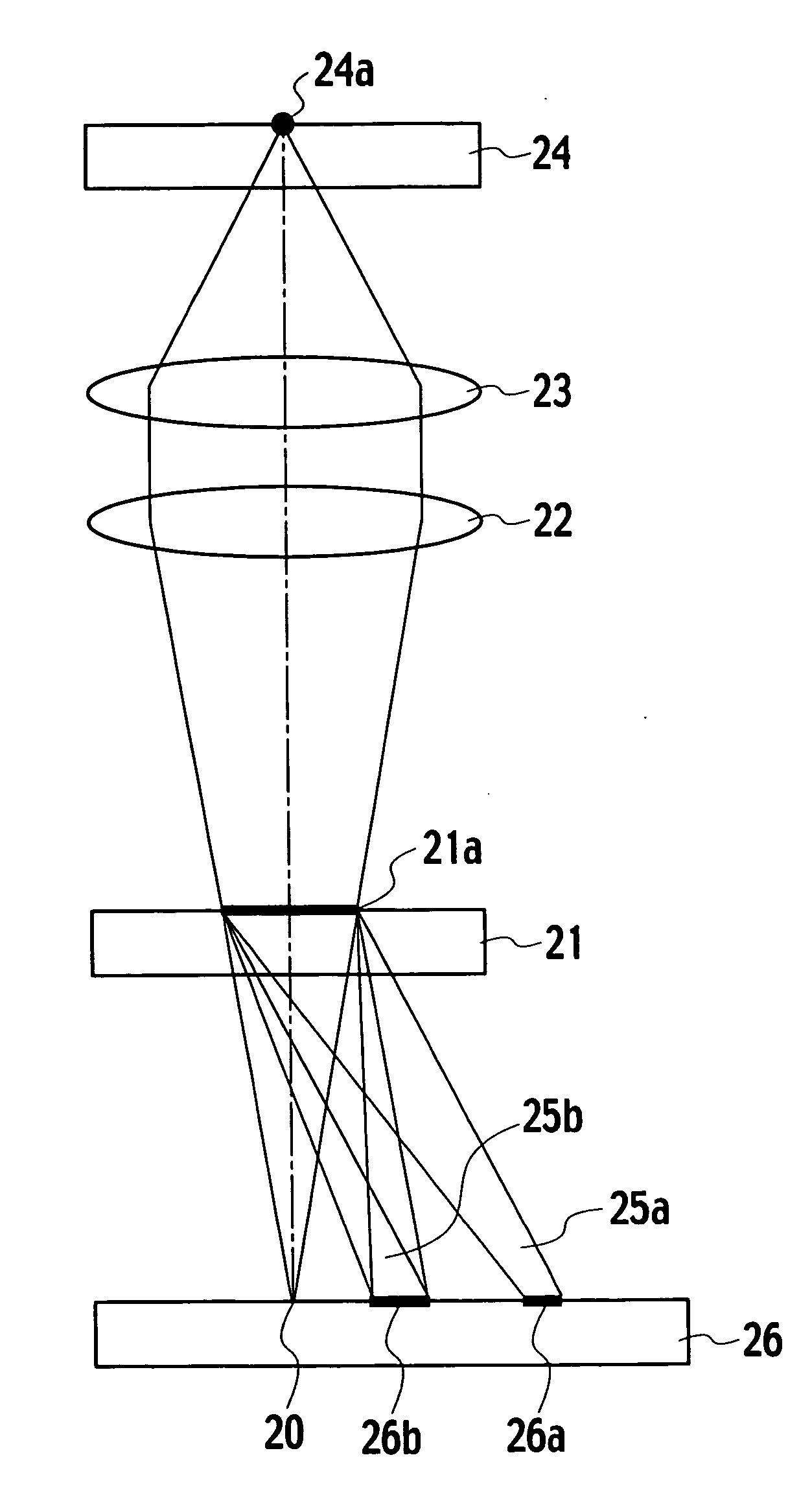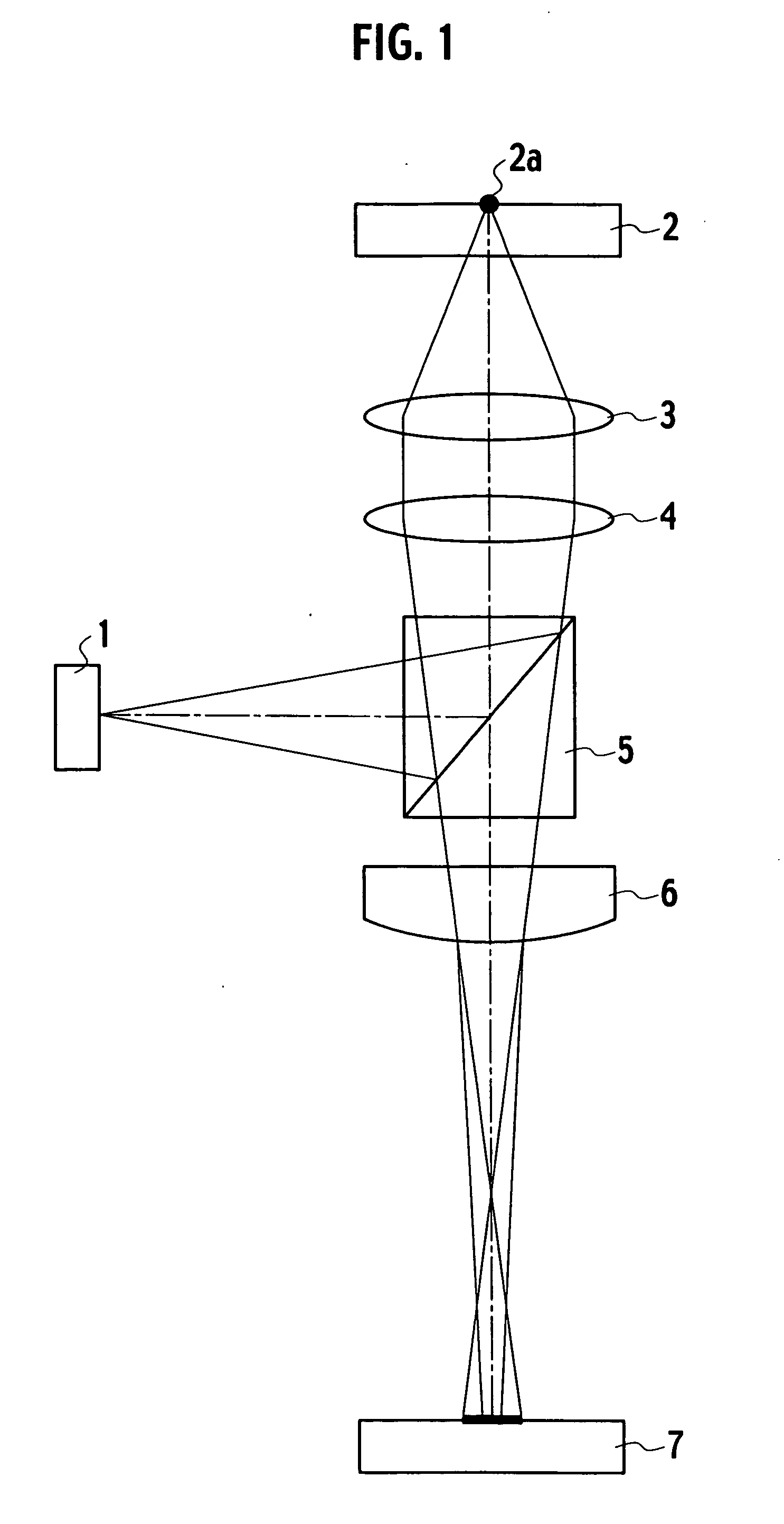Optical pickup device
a pickup device and optical technology, applied in the direction of data recording, instruments, disposition/mounting of heads, etc., can solve the problems of not being able to detect a designated error signal, a lot of trouble and time with the production of optical pickup devices, and an obstacle in miniaturizing the photo pickup devi
- Summary
- Abstract
- Description
- Claims
- Application Information
AI Technical Summary
Benefits of technology
Problems solved by technology
Method used
Image
Examples
first embodiment
[0074]FIG. 9 is a structural view of an optical pickup device in accordance with the present invention. In the figure, light radiated from a semiconductor laser 20 as a light source is transmitted through a hologram element 21, a collimator lens 22 and an objective lens 23, in order. Then, the light is converged by the objective lens 23 to form a light spot 24a on an optical disc 24. The optical disc 24 is formed by, for example, CD (Compact Disc), DVD (Digital Versatile Disc) or the like.
[0075] The light spot 24a is reflected by the optical disc 24 and successively transmitted to the hologram element 21 through the objective lens 23 and the collimator lens 22, in order. The reflection light reflected from the optical disc 24 and entering an area 21a of the hologram element 21 is emitted in diffraction, in the form of two diffraction lights 25a, 25b. These diffraction lights 25a, 25b enter a photo detective element 26 and form two light spots 26a, 26b on the same element 26.
[0076] ...
embodiment
3rd. Embodiment
[0095] According to the third embodiment of the invention, four divided areas 30a˜30d of the hologram element 21 are characterized by diffracting the light reflected on the photo disc and further impressing astigmatism on the diffraction lights, similarly to the second embodiment of the invention. Different from the second embodiment, however, the photo detective element 26 is composed of ten divided detective parts 261A˜261J, as shown in FIGS. 19˜21.
[0096] In detail, as shown in FIGS. 19˜21, the photo detective element 26 comprises three divided detective parts 261A, 261B and 261C receiving the diffraction light from the divided area 30b of the hologram element 21 shown in FIG. 10, three divided detective parts 261D, 261E and 261F receiving the diffraction light from the divided area 30d, two divided detective parts 261G and 261H receiving the diffraction light from the divided area 30a and two divided detective parts 261I and 261J receiving the diffraction light fr...
fourth embodiment
[0105] In order to allow the divided detective part for receiving the light spot 45b to output signals corresponding to the areas A2 and B1 separately, the divided detective part 261B for receiving the light spot 45b is divided into two parts 261B-1 and 261B-2 and additionally, the divided detective part 261E for receiving the light spot 45d is also divided into two parts 261E-1 and 261E-2, as shown in FIG. 22, allowing the tracking error signal to be detected by the phase-difference method. Note that if the relative distance between the objective lens 23 and the optical disc 24 changes from that in the in-focus position, the divided detective parts 261B-1 and 261B-2 receive the light spot 46b of FIG. 23 and the light spot 47b of FIG. 24, while the divided detective parts 261E-1 and 261E-2 receive the light spot 46d of FIG. 23 and the light spot 47d of FIG. 24.
[0106] Assume that in this embodiment respective output signals from the divided detective parts 261B-1, 261B-2, 261E-1 and...
PUM
| Property | Measurement | Unit |
|---|---|---|
| optical power | aaaaa | aaaaa |
| diameter | aaaaa | aaaaa |
| relative distance | aaaaa | aaaaa |
Abstract
Description
Claims
Application Information
 Login to View More
Login to View More - R&D
- Intellectual Property
- Life Sciences
- Materials
- Tech Scout
- Unparalleled Data Quality
- Higher Quality Content
- 60% Fewer Hallucinations
Browse by: Latest US Patents, China's latest patents, Technical Efficacy Thesaurus, Application Domain, Technology Topic, Popular Technical Reports.
© 2025 PatSnap. All rights reserved.Legal|Privacy policy|Modern Slavery Act Transparency Statement|Sitemap|About US| Contact US: help@patsnap.com



